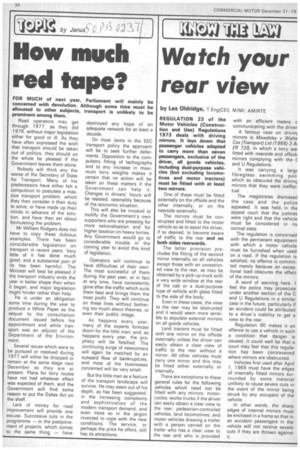Watch your rear view
Page 36

If you've noticed an error in this article please click here to report it so we can fix it.
by Les Oldridge, T.Eng(CE1)
, MIMI, AMIRTE REGULATION 23 of the Motor Vehicles (Construction and Use) Regulations 1973 deals with driving mirrors. It lays down that passenger vehicles adapted to carry more than seven passengers, exclusive of the driver, all goods vehicles, including dual-purpose vehicles (but excluding locomotives and motor tractors) must be fitted with at least two mirrors.
One of these must be fitted externally on the offside and the other internally, or on the nearside externally.
The mirrors must be constructed and fitted to the motor vehicle so as to assist the driver, if so desired, to become aware of traffic to the rear and on both sides rearwards.
The latter provision precludes the fitting of the second mirror internally on all vehicles except those with an unrestricted view to the rear, as may be obtained by a pick-up truck with a very wide window at the rear of the cab or a dual-purpose type of vehicle with glass fitted to the side of the body.
Even in these cases, the view to the rear may be obstructed and it would seem more sensible to stipulate external mirrors on all goods vehicles.
Land tractors must be fitted with one mirror on the offside externally unless the driver can easily obtain a clear view of traffic to the rear without a mirror. All other vehicles must carry one mirror and this may be fitted either externally or internally.
There are exceptions to these general rules for the following vehicles which need not be fitted with any mirrors: motorcycles; works trucks if the driver can easily obtain a clear view to the rear; pedestrian-contro;led vehicles; land locomotives; and motor vehicles drawing a trailer with a person carried on the trailer who has a clear view to the rear and who is provided with an efficient means c communicating with the driver A famous case on drivinc mirrors is Mawdsley v Waite Cox (Transport) Ltd (1966) 3 A) ER 728, in which a lorry mai fitted with nearside and offside mirrors complying with the C and U Regulations.
It was carrying a largE fibreglass swimming poo which so obscured the driving mirrors that they were ineffectual.
The magistrates dismissed the case and the police appealed. It was held in the appeal court that the justices were right and that the vehicle must be considered in its normal state.
The regulation is concerned with the permanent equipment with which a motor vehicle must be furnished when used on a road. If the regulation is satisfied, no offence is committed merely because an exceptional load obscures the effect of the mirrors.
A word of warning here. I feel the police may prosecute under another section of the C and U Regulations in a similar case in the future, particularly if an accident could be attributed to a driver's inability to get a view to the rear.
Regulation 90 makes it an offence to use a vehicle in such a condition that danger is caused. It could well be that a court may feel that this regulation has been contravened where mirrors are obstructed.
Vehicles first used after April 1, 1969 must have the edges of internally fitted mirrors surrounded by some material unlikely to cause severe cuts in the event of the mirror being struck by any occupant of the vehicle.
In other words, the sharp edges of internal mirrors must be enclosed in a frame so that in an accident passengers in the vehicle will not receive severe cuts if they are thrown against it.




























































